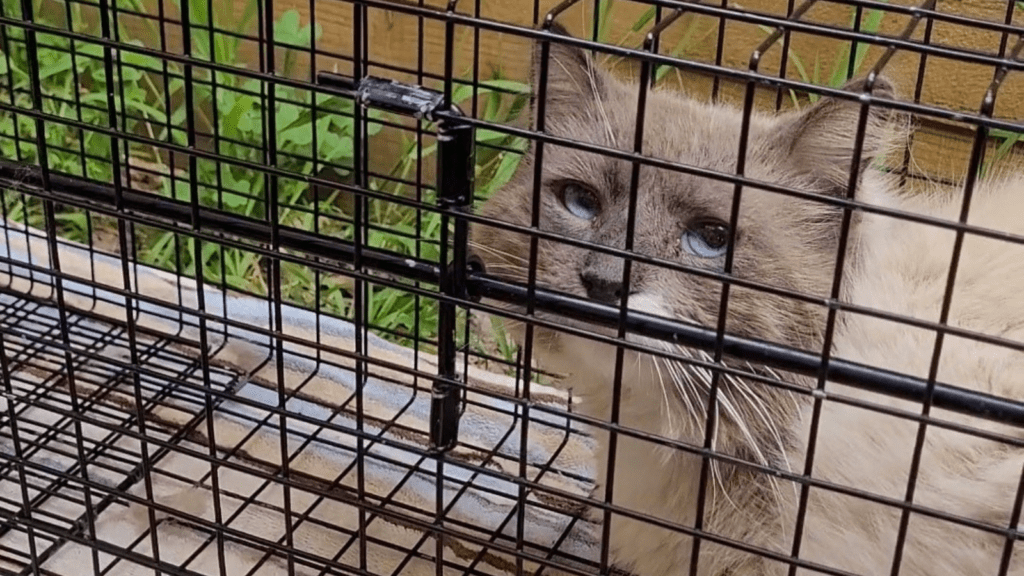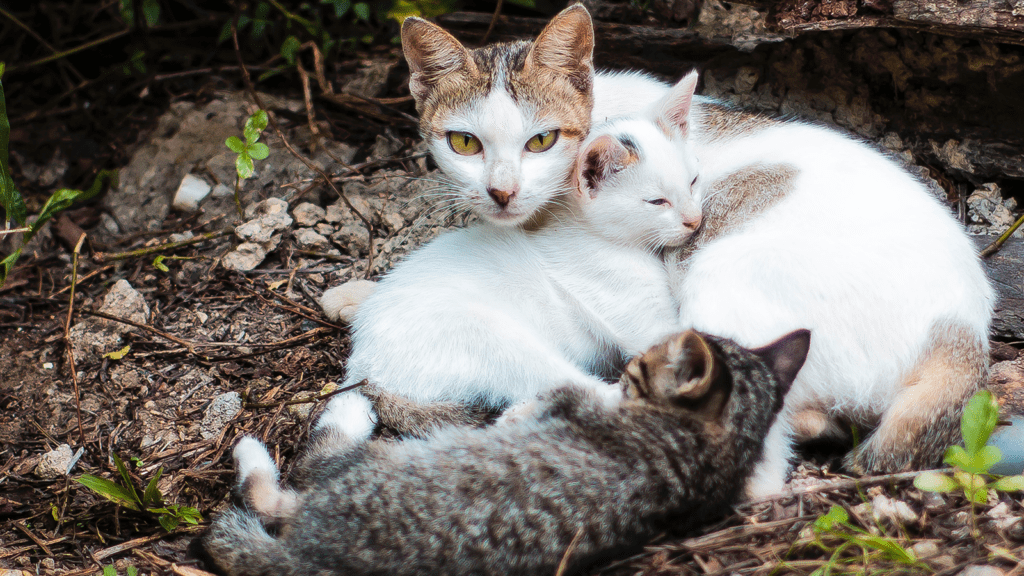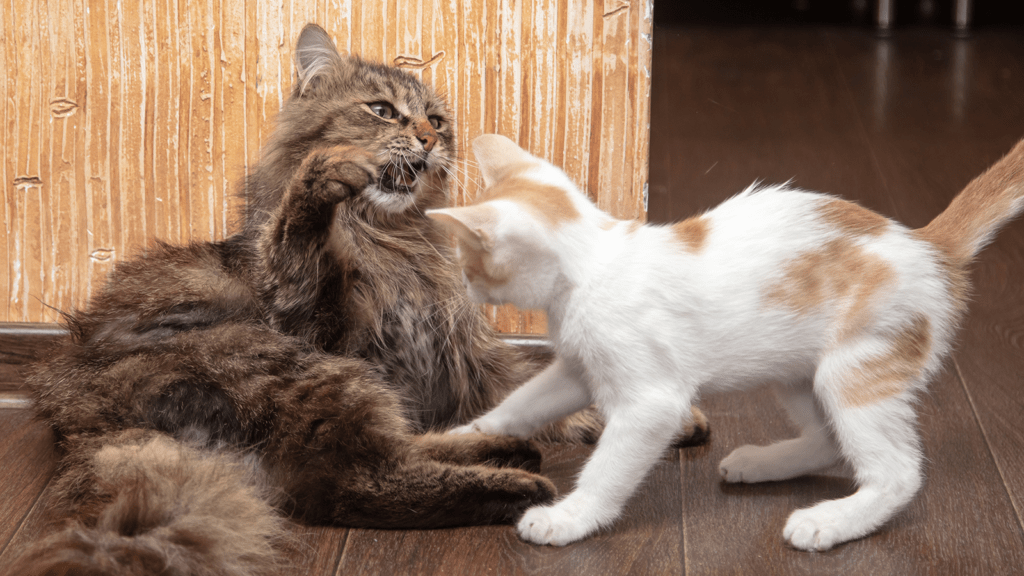
How to introduce two cats
Getting a new cat can be very exciting but also stressful. Cats often don’t take well to change, and introductions between pets can be difficult and time-consuming. Introducing a new cat to a home with existing cats presents unique challenges due to their territorial nature, making a carefully planned introduction process essential. However, there are ways to make it successful.
The key to cat introductions is to take things slowly and phase them into their interactions over time. Begin by introducing them to each other’s scent. Feed them on opposite ends of a closed door. Then, let them see one another without interacting. Finally, allow them to interact while supervised.
Provide them with something to occupy them during the introduction, like a meal or play.
In this article, we’ll answer all your questions about cat introductions, from how to introduce two cats to what to do if they won’t get along.
How Long Does It Take To Introduce Two Cats?
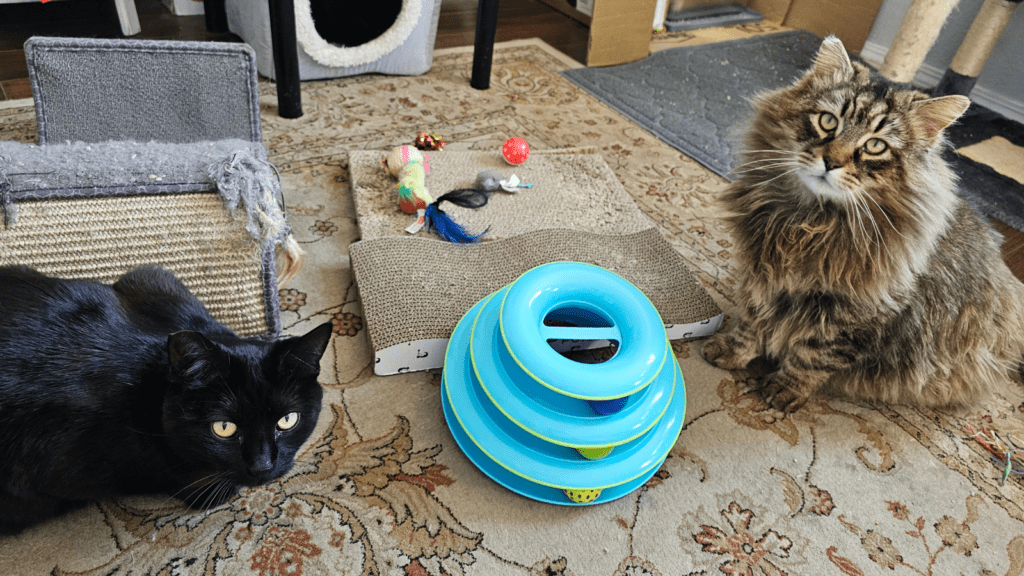
Introducing two cats properly can take weeks to months. It depends on the cats, their personalities, and their histories. It also depends on how you introduce them.
For instance, two well-socialized kittens may get along during their first meeting and become best friends very quickly. They may even become bonded relatively easily.
Two older cats who’ve had bad experiences, such as a house cat who’s been bullied by other cats and a former feral who got in a lot of fights, may take months to years to warm up to one another. They might never be friends, but they will learn to tolerate one another and live in harmony. Introducing an adult cat to a resident cat can be particularly challenging. It is crucial to recognize if the cats will happily accept one another to ensure their physical health and mental well-being.
Cats who have had bad experiences with one another often take much longer to regain that trust—which is why it’s so important to take introductions slowly so that you avoid this result!
When it comes to gender, two male cats may take longer to introduce than a male and a female or two females. However, it shouldn’t make a huge difference when done right.
One thing we do advise is not to introduce two unneutered male cats in a home with a female cat. Even if she is spayed, the boys are likely to fight over her, which can ruin their relationship.
Neutering your male cats will reduce behavioral problems, including fighting, and also give them a longer, healthier life (source).
If you’re struggling to afford the surgery, look into low-cost spay and neuter programs in your area. These are often much cheaper than going to a traditional veterinarian.
Steps To Introduce Two Cats
Introducing cats should be done in parts for the best results. These are:
- Quarantine
- Scent swapping
- Shared meals
- Allowing the cats to see one another
- Supervised interaction
It is also crucial to provide each cat with their own space and resources to ensure a harmonious living situation.
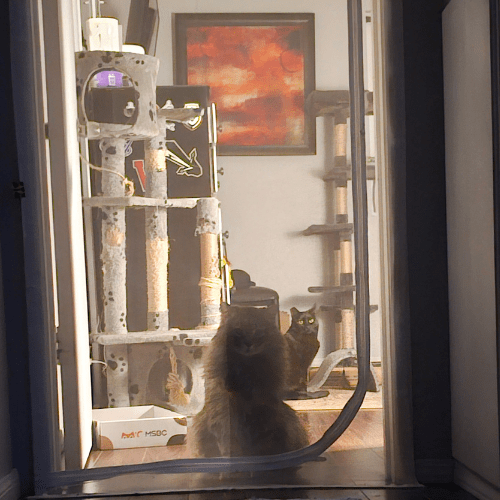
Quarantine In The New Cat’s Room
Whenever you bring a new pet into your home, you want to keep them separate from your other pets. Ideally, this is done in a designated space known as the new cat’s room, which is easy to clean and sanitize if necessary, such as a bathroom. Have one room for the new cat, which can also become the cat’s territory.
Make an appointment with your veterinarian and watch your new kitty for signs of illness. Your veterinarian can advise you during your check-up, depending on your area and the cat’s history. Generally, you’ll want them to check for the following:
- Parasites, such as fleas, worms, or ear mites
- Contagious ailments such as Feline Immunodeficiency Virus (FIV) or Feline Leukemia Virus (FeLV)
- Any additional health concerns that may impact your new cat’s life
Blood tests for any contagious ailments are especially important, as these can be deadly to your old cat if caught.
If you adopted your new cat from a rescue or shelter, you can ask for any veterinary records they have. It’s up to you whether you want to recheck with your own vet or trust theirs.
Once your new cat receives a clean bill of health, you can begin introducing them to other rooms in the house if you can. This isn’t always possible in small spaces, but it is ideal.
However, it’s not yet time to put your cats together or let the new cat free roam!
You can, however, confidently start scent swapping without passing on parasites or illness to your existing cat. (If your new kitty is ill or especially if they had fleas, be sure to wash all of their belongings thoroughly before you begin!)
Scent Swapping
Scent swapping begins by giving your cats each a space in your home, such as a spare bedroom. Your existing cat should be able to free roam while your new cat lives in a bedroom, extra room, or other enclosed space with the door shut.
To create feelings of familiarity and security, use synthetic feline facial pheromone Feliway Classic in both the new cat’s room and in the area where the resident cat spends the most time.
Next, give them items that hold scent. Cat beds, blankets, towels, plush toys, or scratching posts. Anything that your cat can interact with or lay on and add their scent to.
Provide these items for both cats. After they’ve had a few days to a week to lie on the items, rub their face and tail against them, and get them nice and smelly, swap them!
These items likely won’t smell much at all to you, but if you give your new cat something that belongs to your old cat, they’re sure to spend time sniffing it.
During this time, you’ll also want to swap spaces. Move your new cat to another closed room before putting your old cat in the new cat’s space. Then, free the new cat so they can explore your home without interruption.
Cats communicate heavily through scent. When they sniff where the other has been, your cats are already getting to know each other before they even meet!
A great tip is to get a screen for your room so you can open the door, which helps with scent exchange and introduces visual contact.
Shared Meals
Whilst you swap scents between your cats, you can also provide shared meals for them. Now, this doesn’t mean putting them together while they eat—it means feeding them on opposite sides of a closed door.
You can use a baby gate to separate the cats while allowing them to see, sniff, and interact with each other without direct physical contact.
Start at a distance each cat is comfortable with, moving the bowls a little closer during each meal time. Once they’re eating close together with the door between them and they’re used to each other’s scent, you can move on to the next step.
Visualization
This is exciting—your cats finally get to see one another!
Start this process by using a gate, screen door, or even cracking a regular door during meal time. Feed your cats at a distance where they can see each other but not interact. You can also use a door jam on either side of the door to facilitate better interaction between the cats.
Make sure no one hops over the gate or runs through the door. Also, don’t place the food as close together as you were before. This can be stressful for the cats.
Back up the food bowls so they’re at a comfortable distance. As you did before, you can move them closer during each meal time until your cats are once again eating side by side—and this time, you can see one another!
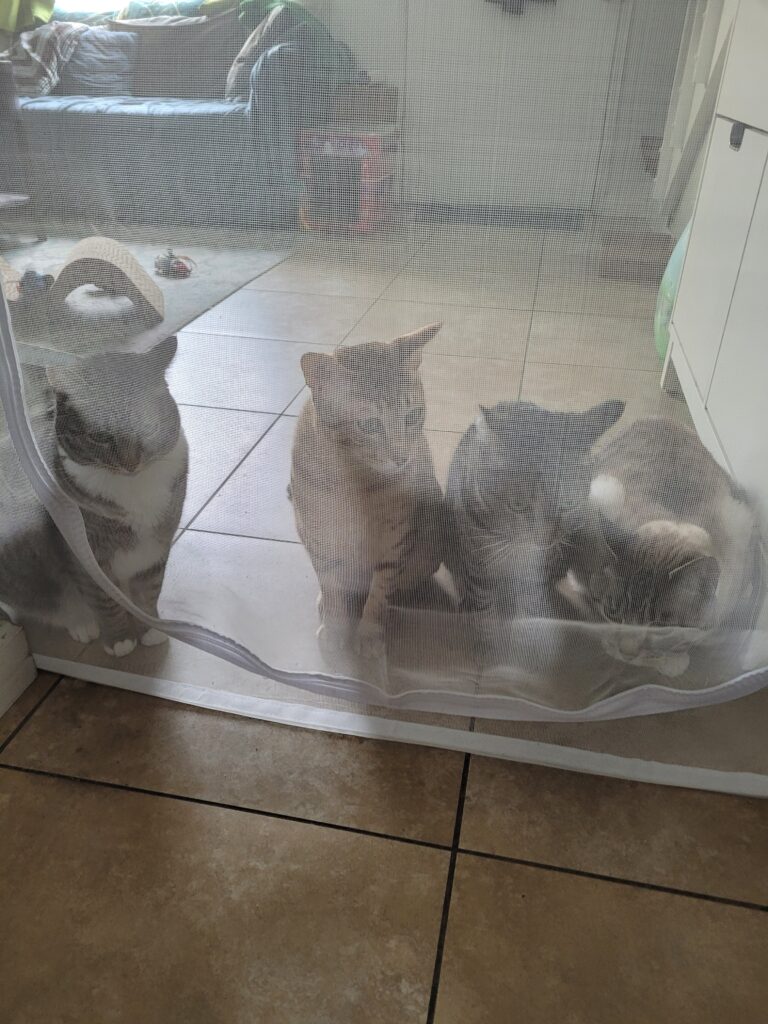
Once they’ve accomplished this, you can move on to the final step—supervised interaction.
Supervised Interactions
This is the final phase of a successful introduction of your cats. You’re going to finally bring them into a room together and allow them to physically interact while supervised but without barriers between them.
It is important to let the cats spend time together gradually, increasing the amount of time they can be together to ensure they get along and can eventually be safe together 24/7.
During this time, your cats should have an activity to focus on, like eating a meal or playing with toys on opposite ends of the room.
You want them occupied, not focusing solely on one another.
Keep supervised interactions short at first, lengthening the time spent together as you go until the cats can spend time together even without these activities.
Ideally, each interaction should end on a positive note, with both cats feeling confident about the experience. Try to end things before they become nervous!
If they chase or fight, separate them and try again another time. You want to have a short positive association. Once they feel relaxed you can begin to gradually extend their time together.
However, you don’t need to step in each time your cats hiss at one another or even bat each other with their paws. They do need to establish boundaries and develop a relationship.
Sometimes, interactions that seem scary to us, like hissing or growling, are just communication.
How To Introduce An Older Cat To A Kitten
Many people worry that their older cat might hurt their kitten, and thus, they’re much more concerned about introducing these cats!
It is crucial to create a peaceful coexistence between the new cat and the current cat to ensure a harmonious living environment.
You can introduce an older cat and a kitten using the steps above, but here are some extra things to note:
- Older cats hurting kittens are rare. Generally, they don’t see the kitten as a threat—but they will put them in their place! To a point, you need to let your older cat establish boundaries with your little one.
- Supervision is still important. While I would be more worried for the older cat in this situation, you still need to supervise the cats around one another to ensure no one is intimidated or hurt.
- Kittens can be annoying to older cats, and boundaries are important. Don’t allow your kitten to chase, intimidate, or annoy your older cat. It’s easy to see this behavior as harmless or even cute—but if you wouldn’t allow it of an older cat, don’t allow it of a kitten!
- The rules now will apply into adulthood for the kitten. A kitten who’s allowed to pounce on an older cat who’s not having it will continue to do so as an adult. The same goes for chasing and any other undesirable behavior!
- If you don’t play with your kitten, the older cat will become a target. All cats need is 30-45 minutes of playtime daily, broken into 10-15 minute sessions. Kittens may need even more to get out their rambunctious energy.
If you don’t play with your kitten, they’re bound to treat your older cat as a plaything. Lack of playtime can also cause your kitten to attack your feet or hands. Bored kittens will chase, bat at, and bite anything that moves—so you want that movement to be a toy!
Generally, our instincts as people tend to be to protect our kittens because they’re small. We try to force our older cats to tolerate them and “be nice,” sometimes not recognizing that we’re denying the older cats boundaries in the process.
It’s healthy for your cat to bop your kitten on the head when they’re getting out of hand or to hiss when they want to be left alone. As long as they aren’t backing the kitten into corners, chasing them (in a non-playful way), or drawing blood, allow them to continue.
How To Introduce An Outdoor Cat To Your Resident Cat
Introducing an outdoor cat to your indoor cat uses the same process outlined above, but there are some considerations to be made.
Outdoor cats acclimating to indoors can take a few months. Cats tend to take three months to become familiar with new surroundings or a new environment. Outdoor cats should have a separate room, ideally with a good vertical space, scratching posts, boxes, and hiding places.
It is important to allow the cats to explore each other’s spaces. Let them sniff each other under a closed door and monitor their behavior for signs of stress as they explore.
These include:
- Feral cats will need a longer adjustment period. Sometimes much longer! Let them get used to being indoors before you begin introducing them to your indoor cat so that you don’t overwhelm them.
- Stray cats are more likely to carry parasites or illnesses. Have them checked by the veterinarian right away and pay extra attention during the quarantine process. Tell your veterinarian that this was an outdoor cat so that they can take that into consideration during the checkup.
- Being indoors is an added stressor for the outdoor cat. Give your new cat added time to adjust to this new experience and keep their first days in your home as stress-free as possible.
- Consider keeping the outdoor cat indoors full-time. You may already know this if you have an indoor cat, but the outdoors poses many risks. Indoor cats are healthier, live longer, and face less stress. (source) It can be difficult for both you and the outdoor cat to adjust to keeping them indoors full-time, but it’s also worth it!
- Don’t forget playtime! Playtime is important for all cats, but particularly for an outdoor cat during this transition period. Outdoors, they can roam and hunt to their heart’s content. Indoors, they need play to mimic hunting and to keep them active.
How To Introduce Cats In A Small Apartment
Small apartments present an extra hurdle for introducing cats. While it can be more difficult to keep them separated, I still recommend it during the introduction process.
Providing separate litter boxes for each cat is crucial to reduce the potential for conflict and promote a harmonious living situation.
In a small space, it’s important to utilize any doors you have available. The new cat will likely have to stay in your bathroom or bedroom since you’re unlikely to have a spare room to keep them in.

Overall, the process is exactly the same as outlined above, just a little trickier due to the limitations of your space. Here are some tips if you are getting ready for a move with your cat.
How To Introduce Two Cats When One Is Aggressive
Introducing an aggressive cat into your home depends on how aggressive the cat is and how you know this. Have they attacked the cat you’re trying to introduce them to? A former cat? Are they simply showing aggressive body language?
Either way, you can follow the process above for your cats, starting with the use of a cat’s room. This room should be equipped with specific items and synthetic feline facial pheromones to create feelings of familiarity and security for the new cat. It will likely work unless your cat is extremely aggressive and unable to be around other cats—which is rare.
If your cat has attacked another cat in the past, this doesn’t necessarily mean they’re aggressive. They might have had a problem with that cat, but like the new cat, they’re introduced to.
If they’ve attacked the cat you’re introducing them to, the process will take longer as it’s a reintroduction. Your cats will have to learn how to get along and redevelop trust, which is difficult to repair once it’s been broken.
If you’re struggling to introduce your cats due to aggression, contact a professional for help. I recommend starting at the veterinarian to rule out health problems in both cats. Then, call a cat behaviorist to help with the introduction.
Should I Let My Cats Fight?
You should never allow your cats to fight it out during introductions or conflict. Fighting won’t resolve their issues and will only lead to worse problems. It can escalate to serious injury or even lead to one of the cats killing the other.
To establish comfort before direct interactions with the existing cat, it is important to provide a separate litter box for the new cat in its own room.
However, you do need to know when to intervene and when not to. Here’s when not to intervene:
- During a play fight
Play fights can look realistic between cats. This is because cat play mimics hunting. They’re going to pounce, kick, and bat at one another.
You might see one cat grab another in their paws and “bunny kick” with their back legs. This is how cats dismantle their prey—but it’s also how they play with other cats.
Kittens learn to hunt through play, and it teaches them valuable life skills. Playtime allows adult cats to finesse their hunting abilities as well!
- When the “fight” isn’t violent
Sometimes cats act in ways that seem violent to us but really aren’t a big deal to them! Examples include hissing, growling, and batting at one another.
For instance, maybe your senior cat takes a few swings at a kitten who nears the senior cat’s food dish. Or, your new cat hisses at your old cat as a way of saying, “Back off!”
These interactions don’t lead to injury and won’t harm the relationship between the cats. It actually helps the relationship to establish boundaries in this way.
How Do I Know If My Cats Are Playing Too Rough?
If you don’t know much about cat body language, you might have read the above and thought, but how do I know if my cats are truly fighting?
Cat play can look pretty violent, especially if you’re new to cats. Kittens, in particular, are known for looking aggressive during play and might lift their hind end or puff up their tail while playing with another cat.
It is important to monitor the cats’ interactions and adapt to their behaviors over time, ensuring each cat has their own space to retreat to and feel comfortable.
Here are some general rules for play fights:
- The cats take turns. If one cat is constantly pinning the other, backing them into corners, or chasing them, this likely isn’t play (or at least, they aren’t playing very nicely!). But if the first cat races after the other, stops, and turns around to be chased, that’s play!
- They take breaks and remain calm. Cats who feel comfortable around one another and who are playing nicely won’t show scared body language, panting, or other signs of distress.
- Your cats get along outside of play. When playtime ends, you may see them grooming one another or sitting peacefully together.
- The play is relatively short. While it might be longer in kittens, neither kittens nor cats tend to play for long periods. If it goes on for a long time and isn’t off-and-on-again, you may be looking at aggression.
- There are no injuries. Cats are smart, and they generally know how to hold themselves back during play. If your cat is drawing blood by biting or scratching the other, this isn’t play and needs to be stopped immediately.
If your cats are truly fighting, separate them immediately and go back to square one to reintroduce them.
This will likely take longer than the first time because now, the cats have a negative experience with one another. (It’s kind of like if someone came into your home and slapped you—you’d definitely need some time and space to trust them again!)
Is It Normal For Cats To Hiss When Introduced?
Yes, hissing is normal! Cats hiss when they’re feeling scared, territorial, or aggressive. They also hiss to establish boundaries.
Allowing the resident cat to explore the new cat’s area and the new cat to explore the resident cat’s area can help ease the introduction process.
Hissing in itself isn’t a bad sign. It may or may not lead to increased aggression, depending on the cats.
Typically, cats like to avoid confrontation. When one cat hisses, the other cat will often respect that boundary and either walk away or make themselves smaller, showing they don’t mean any harm.
Of course, some cats don’t respect boundaries—they might keep pushing until they get a stronger show of aggression, such as a swing of the paw or even a bite.
It’s important to keep an eye on the cats until you know which way things will go. Supervision is key during introductions.
Can Two Alpha Male Cats Live Together?
Yes, two territorial or “dominant” male cats can live together peacefully. However, it may take them some time to get used to each other due to their strong personalities.
Creating positive associations between the cats through various techniques is crucial for fostering a peaceful coexistence.
It’s also important to note, however, that “alpha males” don’t exist! This term is typically used to refer to dogs due to a faulty study done on wolves (source).
In this study, captive wolves were observed to learn more about their social hierarchy. It was determined that wolves lived in packs dominated by an alpha or a leader. It was thought that the wolves were aggressive within the pack and might even kill the leader in order to take their place.
For some reason, this was then applied to dogs and produced a training method known as the dominance theory of dog training.
However, the entire study has been disproven. We now know that in the wild, wolves live in families consisting of a mother, father, and pups.
The parents are in charge, much like in human families, and they don’t tend to be violent with one another. After all, it makes more sense to work together to ensure the pack’s survival!
Dominance theory is often criticized because dogs aren’t wolves—and cats especially aren’t!
Cats live in colonies, not packs, and they don’t tend to have a strict hierarchy. They can live together harmoniously, especially once spayed and neutered. Female cats even care for one another’s offspring.
My Cats Won’t Get Along After Introducing Them
If you introduced your cats wrong the first time around, or they’ve had a falling out, this can be incredibly frustrating.
Our best advice is to start at square one or go back a step and reintroduce them using the method outlined above. Take it slow and be prepared for a long process.
Providing plenty of resources, including separate food and water bowls, perches, beds, toys, attention, and litterboxes, is crucial to helping them coexist peacefully.
If introducing your cats doesn’t seem to be working, here are some troubleshooting tips:
- Playtime is crucial. If your cats aren’t getting at least 30-45 minutes of playtime with you every day, start there! It will give the aggressor an outlet for their energy and help the bullied cat gain confidence.
- Provide plenty of resources. This includes separate food and water bowls, perches, beds, toys, attention, and litterboxes. Two cats need at least three litterboxes and two to four scratching areas. Here are some of our favorite cat products!
- Take things even slower. Modify the steps above. For instance, try hanging a blanket over a pet gate and lifting it slowly over time. This will make it so your cats aren’t seeing each other all at once and make that step more gradual. You can also start physical introductions by keeping them on separate corners of a room and allowing them closer in time.
If you eventually choose to rehome one of your cats, please do so responsibly. Never dump them outside. If you must, you can surrender your pet to a shelter.
Do the right thing by your cat and bring them to a rescue organization or find them a good, loving home. Always research potential adopters to ensure they have good intentions and will care for the cat properly.
If you can find someone you know to take them or even a friend of a friend, this is usually the best for the cat.
Conclusion
Take cat introductions slowly, step by step, and you’re sure to see success. Never put two cats in a room together to “fight it out,” as this can lead to disastrous results.
Remember, taking cat introductions slowly and providing enough resources is crucial for a harmonious household. Learn about cat body language, supervise your pets during introductions, and be sure to provide enough resources so that your cats don’t become territorial.
We wish you and your furbabies an amazing life together!


